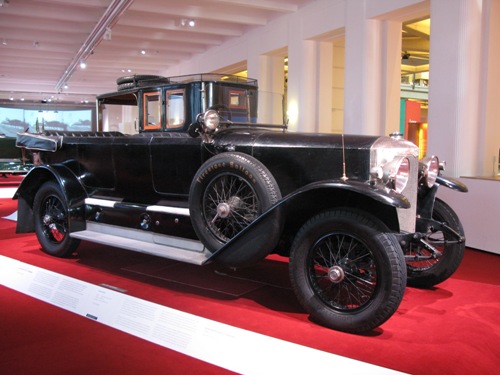
Gräf & Stift 40/45 HP
1913
Shortly before the onset of "the last days of mankind" with the Great War, this automobile was still spruce-green. For its deployment on the front, the Double Phaeton was given its regulation coat or military grey paint, shortly after Count Kinsky, the Emperor’s Oberstallmeister, had taken possession of the Gräf & Stift Type 40/45 HP, chassis No. 193, for the "higheset of all appointments" in August 1914, the month in which war broke out. The automobile was in fact used only Emperor Franz Joseph's successor. Charles I, who was crowned emperor in 1916, used the Gräf chassis, whose coachwork was converted into a luxury Double Phaeton by the firm of S. Armbruster, first and foremost to inspect the troops along the southern front. In all probability, it is the same vehicle referred to by Anton Kuh in his anecdotal historical note entitled "Das Hofauto": It was graciously made available by Charles personally to the elderly founder of Austria's Social Democratic Worker’s Party, Victor Adler, in the first November days of 1918 for a journey to the Ministry. One fact which has been established is that this Gräf accompanied the Emperor and his family into exile in Switzerland following Charles’s abdication. After the attempts at restoration in Hungary, Charles was forced to go to Madeira in 1921. The automobile remained in Switzerland. The police constable Fritz Huwyler, Charles's personal bodyguard, acquired the automobile, which had once been an official state car. His brother Anton Huwyler is said to have driven it right up until the 1930s. The Emperor's last automobile finally returned to Vienna again after it was auctioned off on 21 March 1974.

Packard Twin Six Phaeton Series II
1917
Between the Wars, the Packard Motor Car Company was one of the great makes, in two ways: it produced high quality in large numbers. In 1928 alone, the last year before the stock market crash, 41,000 vehicles came off the assembly line, tiwce the total production of Rolls-Royce in Britain and the US between 1919 and 1939. Packard even exceeded Bugatti’s all-time output six-fold. Already in 1917, the first year of production, 10,000 Packard Twin Six models were sold all over the world. The mass-produced luxury product with no claim to exclusivity also appealed to high-ranking customers, the Emperor Nicholas II of Russia also ordering one. The same model was used by Warren G. Harding, who became the first Amerian President to drive his own investiure.
The engineering core of the Packard Twin Six was the world’s first mass-produced V12 engine. With a capacity of 7 litres and a power output of 88 bph, the side-valve engine achieved a top speed of 130 km/h in an all-wheel driven car with open coachwork. At Daytona Beach in 1919, a new speed record of 283 km/h was established using a reworked racing version of the engine. After driving a Packard Twin Six, the young Enzo Ferrari was said to be so enthusiastic about the performance and smoothness of the twelve-cylinder engine that he vowed there and then that one day he would build such an engine himself.

Austro Daimler AD 6-17 Jagdwagen
1922
Of all the companies Ferdinand Porsche worked for, Austro-Daimler was the one he stayed with the longest. He was head of technical development for 17 years, between 1906 and 1923, rising to the position of director in 1917. In fact, he headed the company known as "Österreichische Daimler Motoren Gesellschaft" during one of its most difficult phases. The end of the war initially entailed a significant decline in production and sales.
Porsche banked on the company’s core competence, i.e. automobile construction, and first sought to rekindle past successes using pre-war models. The large-capacity AD 6-17 was the first new design after the war, and it enabled the company to rejoin the international luxury car entile. In designing the 17/60 bhp engine, Porsche switched to light-weight construction, i.e. single blocks with impressed cylinder sleeves, light-alloy pistons, and a vertical camshaft drive. In 1923, Ferdinand Porsche left the works based in Wiener Neustadt and took up a new position at the former Daimler parent company, now a rival.
Ferdinand Porsche's move to Stuttgart signaled the arrival of an exceptional automotive engineer proficient in all aspects of automobile development. The designer’s style, last seen on the AD 6-17, is evident in the new developments that came out of Stuttgart-Unter türkheim, right through to the Mercedes-Benz 710 SS and SSK. This AD 6-17 Phaeton was owned by Ferdinand Porsche himself.
